Animals
What to Do If Your Animal Has Been Poisoned: A Step-by-Step Guide
Take immediate action if your pet has been poisoned – quick response is key to their well-being and recovery.

If your animal has been poisoned, it's essential to act quickly for their well-being. Start by identifying the poison by checking for visible clues or signs of exposure. Remove your pet from the source of poisoning and contact a vet immediately. Provide details on the poison type and symptoms to assist in treatment.
Monitor your pet's signs, and remember to secure toxic substances to prevent future incidents. Taking swift and precise action in such situations is critical for your pet's recovery and safety.
Key Takeaways
- Remove the pet from the poison source immediately.
- Contact a veterinarian or poison control hotline promptly for guidance.
- Avoid inducing vomiting without professional advice.
- Provide detailed information to the vet about the poison and symptoms.
- Monitor vital signs and seek professional veterinary care promptly.
Identifying the Poison
To properly identify the poison in cases of animal poisoning, we must meticulously examine the surroundings for any visible clues such as open containers, spilled substances, or missing items. It's essential to take into account the presence of poisonous plants in the vicinity, as they could be a potential source of toxicity. Additionally, if there are signs of skin exposure to certain substances, it might offer valuable insight into the type of poison involved.
In a veterinary practice or emergency service setting, where time is of the essence, swift action is paramount. Checking for labels and packaging of potential toxins can help determine the nature of the poison, aiding in prompt diagnosis and treatment. Observing any changes in the animal's behavior or symptoms post-exposure is also crucial in narrowing down the possible sources of poisoning.
Seeking immediate veterinary advice is indispensable in accurately identifying the poison and providing appropriate treatment tailored to the animal's condition. By being meticulous and thorough in our examination of the surroundings and taking all possible factors into account, we can effectively pinpoint the poison and take the necessary steps to guarantee the animal's well-being.
Immediate Actions to Take

After identifying the poison and evaluating the situation, the immediate actions to take in cases of animal poisoning involve:
- Removing the pet from the source of poisoning
- Contacting a veterinarian or animal poison control hotline promptly
- Refraining from inducing vomiting unless advised by a professional
It's important to act swiftly but calmly in such situations. Poisons that can harm animals include common household items like chocolate, certain plants, medications, and chemicals.
Once the pet is safely away from the toxin, contact a veterinarian or poison control hotline for specific guidance tailored to your pet's situation. Providing details about the poisoning incident, such as the type of toxin if known, will assist the professionals in offering the best advice. Remember not to try inducing vomiting without proper guidance, as this can sometimes do more harm than good.
Safely transporting your pet to the vet for assessment and treatment is crucial for their well-being.
Contacting a Veterinarian
Upon suspecting that your animal has been poisoned, contacting your veterinarian immediately is essential for receiving timely professional guidance.
When reaching out to your vet, provide essential details such as the type of poison, the amount ingested, and any observed symptoms. This information allows the veterinarian to assess the situation accurately and recommend appropriate steps.
Be prepared to follow the veterinarian's instructions diligently, which may involve bringing the poisoned animal in for examination and treatment. Inform the vet about any first aid measures you've already taken before seeking professional help.
Prompt and clear communication with the veterinarian is critical to guarantee the best possible outcome for your poisoned animal. Remember, the more precise information you can provide about the poisoning incident, the better equipped your veterinarian will be to assist your beloved pet.
Treatment and Recovery

When moving from contacting a veterinarian to discussing treatment and recovery for a poisoned animal, close monitoring of essential signs and symptoms becomes vital in guiding the course of action for excellent care.
Here are some key steps to ponder during the treatment and recovery process:
- Monitor Essential Signs: Keeping a close eye on your poisoned pet's essential signs, such as heart rate, respiratory rate, and temperature, can help gauge their progress and inform the treatment plan.
- Provide Professional Care: Seek expert veterinary care promptly to guarantee your pet receives the necessary medical attention, which may include supportive care like IV fluids and medications to aid in the recovery process.
- Follow-Up with Veterinarian: Schedule follow-up appointments with the veterinarian to track your pet's recovery progress, make any necessary adjustments to the treatment plan, and ensure they're on the right path to full recovery.
Preventing Future Poisoning Incidents
To prevent future poisoning incidents, securing all toxic substances in inaccessible locations is essential to safeguard pets from accidental ingestion. Utilizing childproof locks on cabinets containing cleaning products, medications, and other potential toxins can further prevent pets from accessing harmful substances.
It's important to keep all houseplants that are toxic to animals out of reach or replace them with pet-safe alternatives to minimize the risk of poisoning. Regularly inspecting your home and yard for any potential hazards that could be poisonous to animals is a proactive measure in maintaining their safety.
Educating yourself and your family members on the common household items that can be toxic to pets is crucial in preventing future poisoning incidents. Understanding the dangers associated with certain substances can help create a safer environment for your beloved animals.
Frequently Asked Questions
What to Do if an Animal Is Poisoned?
If an animal is poisoned, we must act quickly. Move them away from the toxin, contact a vet or poison control, and provide details on the incident.
Never induce vomiting or offer food/water without professional advice. Transport the pet to the vet for proper care.
Time is vital in these situations, so swift action can save a life.
What Should You Do After Being Poisoned?
After being poisoned, we must seek immediate help. Call emergency services or poison control for guidance.
Don't delay, as prompt action can save lives. Stay calm and provide details for accurate assistance. Follow their instructions closely to guarantee the best outcome.
How Do You if Your Dog Has Been Poisoned?
If your dog has been poisoned, it's important to look for signs like vomiting, diarrhea, drooling, tremors, or seizures. Keep track of potential toxins they may have encountered, such as plants, foods, medications, or chemicals.
Contact a vet immediately for guidance and treatment options. Avoid inducing vomiting without professional advice to prevent complications. Safely take your dog to the vet for prompt evaluation and care in case of suspected poisoning.
Does Milk Help a Poisoned Dog?
No, milk doesn't help a poisoned dog. It's important to understand that giving milk to a poisoned dog can worsen the situation rather than provide relief.
This action may not effectively counteract the toxic substance and could potentially induce vomiting, further dehydrating the dog.
To guarantee the best outcome for your pet, seek immediate veterinary care and follow professional guidance. Trusting milk as a remedy for poisoning isn't recommended and could be harmful in certain cases.
Is the Step-by-Step Guide for Poisoned Animals Applicable to Insects as Well?
The step-by-step guide for poisoned animals may not be directly applicable to insects, especially concerning bugs and fall damage. Insects have different anatomies and behaviors that may require specialized treatment. It’s important to consult experts or literature specifically addressing insect poisoning to ensure accurate and effective care.
Conclusion
To wrap up, it's crucial to act swiftly and decisively if your beloved pet has been poisoned. By following the steps outlined in this guide, you can guarantee that your furry friend receives the necessary care and treatment.
Remember, time is of the essence in these situations, so don't hesitate to reach out for help. By being proactive and informed, you can assist your pet in recovering and prevent any future mishaps.
Remember, an ounce of prevention is worth a pound of cure.
As our Editor-in-Chief, James plays a pivotal role in ensuring the quality and integrity of our content. With a keen eye for detail and a passion for storytelling, James oversees the editorial process here at A Place for Animals. With years of experience in content editing, James ensures that every piece of content meets our high standards of accuracy and clarity. Under James’ guidance, you can rest assured that the content you read is informative and impeccably crafted.

Animals
Which Small Animal Looks Like a Chipmunk?
Are you curious about animals resembling chipmunks? Discover fascinating creatures with unique stripes and survival strategies in this insightful article.
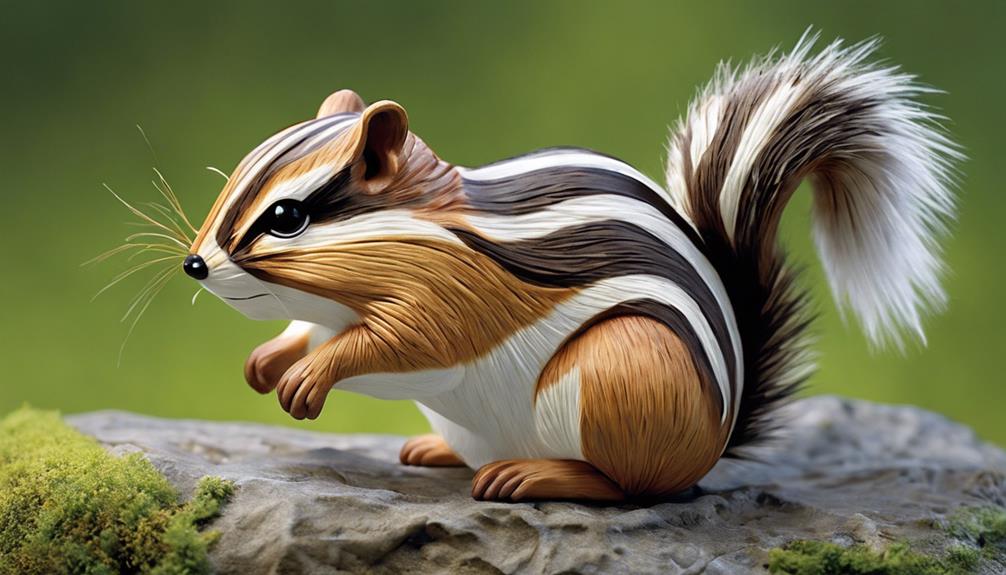
If you're wondering about animals resembling chipmunks, the Thirteen-Lined Ground Squirrel, Eastern Chipmunk, Least Chipmunk, and Colorado Chipmunk are similar. They all have unique stripes, cheek pouches, and quick movements for survival. The Thirteen-Lined Ground Squirrel thrives in grasslands, while the Eastern Chipmunk has reddish-brown fur and excellent climbing skills. The Least Chipmunk survives harsh winters through torpor, and the Colorado Chipmunk sports distinctive stripes for camouflage. Each of these creatures showcases fascinating adaptations for their habitats.
Key Takeaways
- Uinta chipmunks resemble chipmunks with black and white facial stripes.
- They have reddish-brown fur and gray undersides.
- Bushy tails aid in balance and add charm.
- Agile and dart around habitats effortlessly.
- Inhabit forests, meadows, and rocky areas, showcasing adaptability.
Thirteen-Lined Ground Squirrel
Thirteen-Lined Ground Squirrels, often mistaken for chipmunks, are small rodents known for their distinctive 13 alternating dark and light stripes on their back. These Ground Squirrels can be found in grasslands and prairies across North America, showcasing their remarkable adaptability to diverse environments. One key feature that sets them apart from chipmunks is their quick movements and burrowing behavior, allowing them to swiftly navigate their surroundings and create intricate tunnel systems underground.
Observing Ground Squirrels in their natural habitat can be an exciting experience, as they showcase agility and resourcefulness in their foraging activities. Their keen sense of awareness helps them detect potential threats, enabling quick actions to safeguard their safety. Additionally, their burrowing capabilities play an essential role in sheltering them from predators and extreme weather conditions.
Eastern Chipmunk
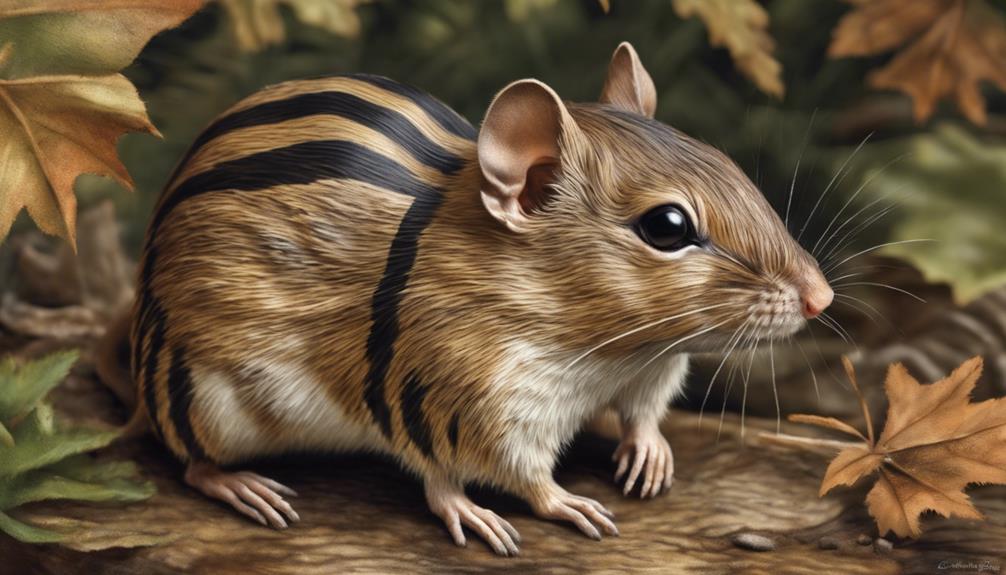
The Eastern Chipmunk, also known as Tamias striatus, is a small rodent with distinct black and white stripes on its back and face.
Their reddish-brown fur adds to their unique appearance in wooded areas.
These chipmunks are active during the day, foraging for nuts, seeds, berries, and insects, showcasing their excellent climbing abilities.
Physical Characteristics
With their petite size and distinctive striped fur, Eastern chipmunks are easily recognizable in their natural habitat. These small creatures typically measure around 5-6 inches in length, sporting reddish-brown fur with black and white stripes on their face, body, and tail.
One key feature of Eastern chipmunks is their large cheek pouches, which they use for storing food. Their quick movements and agility help them navigate their environment with ease.
While Eastern chipmunks share some physical characteristics with Least chipmunks, such as their size and striped fur, they can be distinguished by subtle differences in coloration and markings.
Habitat and Behavior
In their natural habitats, Eastern Chipmunks showcase remarkable climbing skills and territorial behaviors, making them intriguing creatures to observe. These small animals are native to North America, inhabiting forests, woodlands, and even suburban areas. With their excellent climbing abilities, Eastern Chipmunks use trees and shrubs as pathways and lookout points.
They're diurnal creatures, actively foraging for nuts, seeds, fruits, and insects to store in their underground burrows. Eastern Chipmunks are also territorial beings, marking their territories with scent glands and vocalizations to communicate with other chipmunks. During winter, they enter a state of torpor, reducing their metabolic rate to conserve energy and survive the cold season.
Least Chipmunk
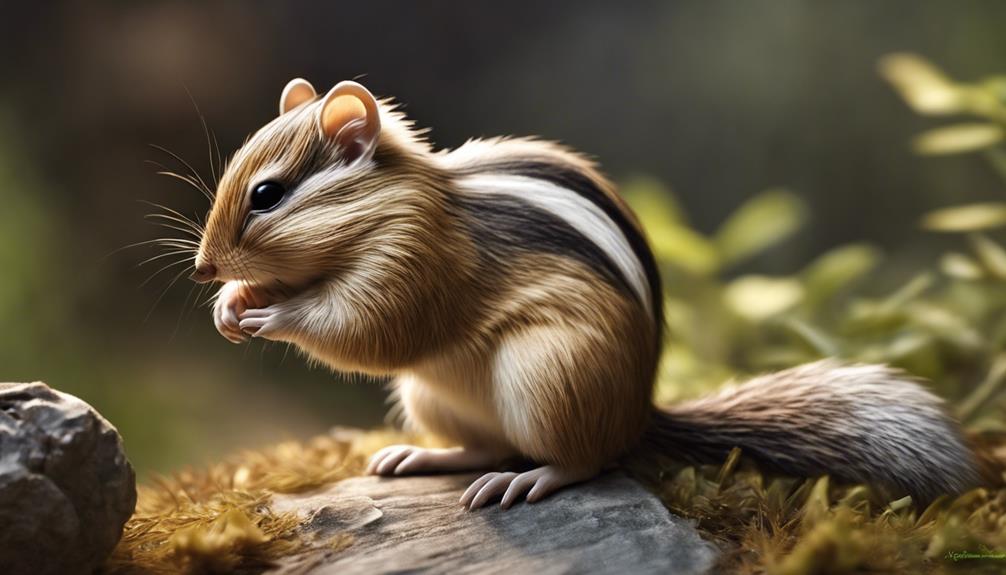
Nestled among the vibrant habitats of Colorado, roams a pint-sized chipmunk known as the Least Chipmunk. This little critter stands out with its distinctive stripes that run from its nose all the way to its tail. These stripes are like nature's signature on this tiny creature, making it easily recognizable amidst its surroundings. Despite its small size, the Least Chipmunk is a resilient species, capable of surviving harsh winters by entering a state of torpor. This adaptation allows them to conserve energy and endure the cold conditions until better times arrive.
You can spot these unique chipmunks in various habitats across Colorado, where they scurry around, foraging for food and scampering up trees with impressive agility. Their striping pattern serves as a natural camouflage, helping them blend into their environment while also adding a touch of beauty to the landscape. The Least Chipmunk is truly a fascinating creature that adds charm to the Colorado wilderness.
Colorado Chipmunk
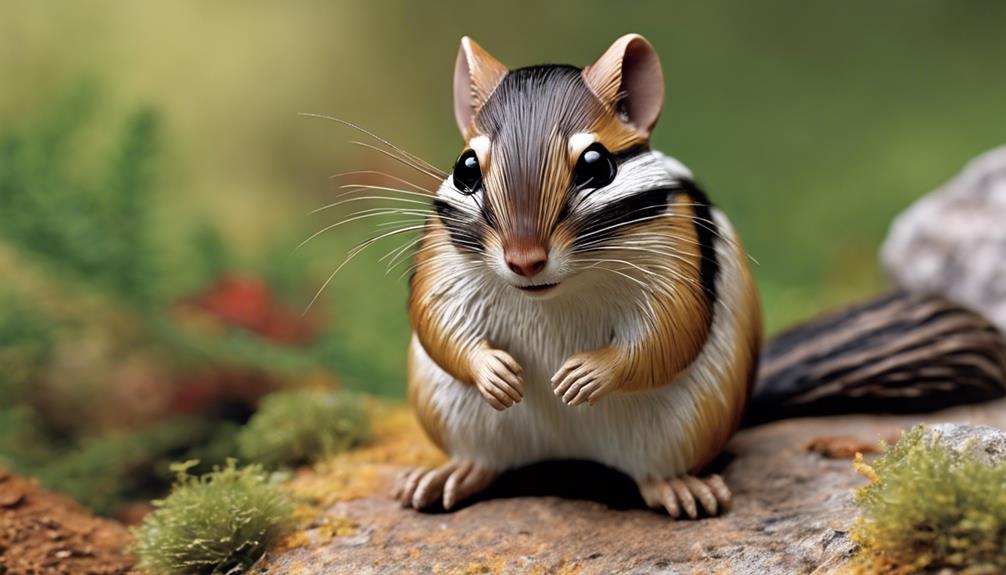
Scampering through the forests of Colorado, the Colorado Chipmunk showcases its larger size and distinctive stripes running from nose to tail. Unlike the Least Chipmunk, this species stands out with its significant markings, making it easily recognizable in its diverse habitats across Colorado. One key feature of Colorado Chipmunks is their cheek pouches, which they use to store food for later consumption. During the winter months, these chipmunks enter a state of torpor to conserve energy and survive the cold weather.
One of the most striking characteristics of Colorado Chipmunks is their stripes, which serve as a notable identifier for this species. These stripes not only add to their visual appeal but also play an important role in camouflage and protection from predators. By blending in with their surroundings, Colorado Chipmunks can stay safe while foraging for food. Next time you're exploring the forests of Colorado, keep an eye out for these charming creatures with their distinctive stripes!
Siberian Chipmunk

Sporting distinctive black and white stripes on its back, the Siberian Chipmunk, also known as the Korean Striped Chipmunk, hails from regions like Korea, China, and Russia. These chipmunks are smaller in size, typically measuring around 5 to 6 inches in length. With reddish-brown fur coloration, they're skilled climbers that forage for nuts, seeds, fruits, and insects in their natural habitat. Siberian Chipmunks aren't only known for their charming appearance but also for their playful and curious behavior, making them entertaining animals to observe.
In the wild, chipmunks like the Siberian Chipmunk play an essential role in their ecosystems by dispersing seeds and balancing insect populations. Their agility and quick movements help them evade predators, showcasing their adaptability in various environments. Observing these chipmunks in their natural habitat provides valuable insights into their behaviors and interactions with other species. By learning about the Siberian Chipmunk, we gain a deeper appreciation for the diversity and uniqueness of chipmunks worldwide.
Red-Tailed Chipmunk
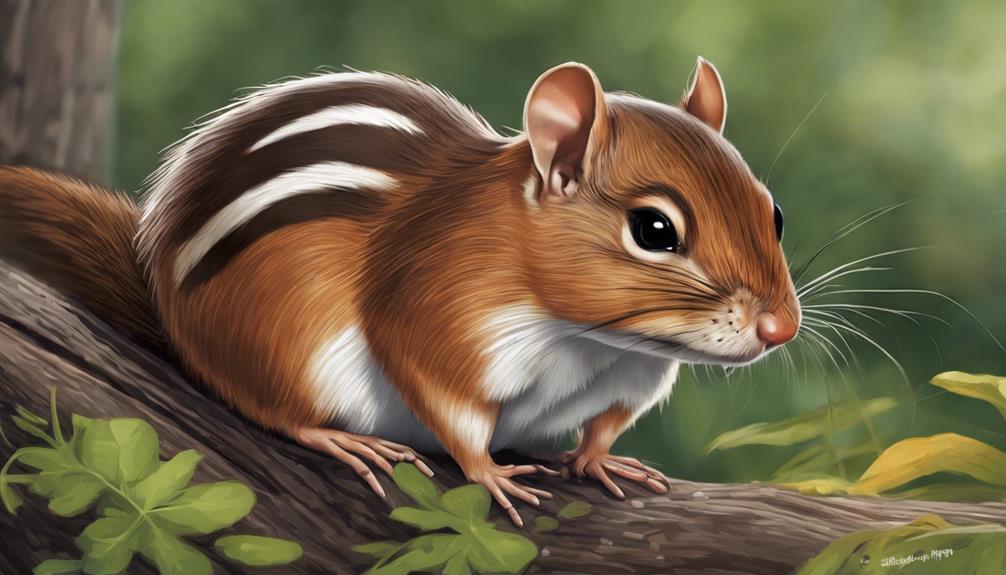
In comparison to the Siberian Chipmunk, the Red-Tailed Chipmunk, also known as the Uinta Chipmunk, inhabits the western United States and is characterized by its reddish-brown back and tail, along with distinct facial markings.
- Distinct Features:
- Red-Tailed Chipmunks stand out with their reddish-brown backs and tails, which sharply contrast with their grayish sides and white underparts.
- Facial Markings:
- These chipmunks sport unique facial stripes and markings, including dark lines that run from their eyes to their ears, giving them a distinctive appearance.
- Habitat and Behavior:
- Active during the day, Red-Tailed Chipmunks forage for a variety of foods like seeds, nuts, fruits, and insects in their forested habitats.
- Ecological Importance:
- Playing an essential role in their ecosystem, these chipmunks aid in seed dispersal and serve as prey for a range of predators, contributing to the balance of their natural environment.
Uinta Chipmunk

The Uinta Chipmunk, scientifically known as Neotamias umbrinus, boasts reddish-brown fur marked by five dark stripes on its back and distinctive white stripes encircling its eyes.
Living in the western United States, these chipmunks thrive in mountainous terrains where they display impressive climbing skills while foraging for a diet of seeds, nuts, fruits, and insects.
Understanding the Uinta Chipmunk's characteristics, habitat preferences, and behaviors is essential to appreciating their significance in maintaining biodiversity within their ecosystems.
Uinta Chipmunk Features
With their distinctive black and white stripes and quick movements, Uinta chipmunks are small rodents native to western North America. Here are some key features that set them apart:
- Coloration: Uinta chipmunks sport black and white stripes on their faces and bodies, with reddish-brown fur and a grayish underside.
- Tail: These chipmunks have bushy tails that add to their charm and aid in balance.
- Movement: Known for their agility, Uinta chipmunks are quick on their feet, darting around their habitats with ease.
- Habitats: You can find these fascinating chipmunks in diverse environments like forests, meadows, and rocky areas, showcasing their adaptability and resourcefulness.
Habitat and Behavior
Nestled within the diverse landscapes of western United States, Uinta Chipmunks exhibit solitary behavior as they skillfully forage for seeds, nuts, and berries. These chipmunks are highly adaptable, inhabiting forests, meadows, and rocky areas with ease.
Agile climbers, they navigate tree branches and rocky terrain effortlessly. Uinta Chipmunks' reddish-brown fur and distinctive facial stripes provide excellent camouflage in their natural surroundings.
Active during the day, they retreat to their burrows at night for safety. Observing their diurnal habits can be a fascinating experience, as they go about their foraging and climbing activities.
Conservation Status
In the conservation efforts for the Uinta Chipmunk, focus remains on preserving its natural habitats to guarantee continued presence in the wild.
Here are four key points regarding the conservation status of chipmunks like the Uinta Chipmunk:
- IUCN Red List: Uinta chipmunks are classified as a species of least concern, indicating that their population is relatively stable.
- Habitat: Found in western U.S. mountainous regions, these chipmunks face threats from habitat loss due to human activities and climate change.
- Population Trend: Fortunately, the population trend for Uinta chipmunks is stable, with no immediate threats impacting their numbers.
- Conservation Focus: Efforts are directed towards safeguarding the natural habitats of chipmunks to ensure their survival in the face of potential challenges.
Yellow-Pine Chipmunk

Yellow-Pine Chipmunks, commonly found in the western United States, boast distinctive yellow and gray striped fur patterns. These endearing chipmunks, smaller than other species at around 8 inches long, are known for their charming appearance and lively nature.
With their cheek pouches for storing food, Yellow-Pine Chipmunks are efficient gatherers, collecting seeds, nuts, fruits, and insects to sustain themselves. Their diurnal habits make them a delight to observe during the day, scurrying around in search of sustenance.
Found in various habitats ranging from forests to meadows, these chipmunks are adaptable creatures, showcasing their resilience in different environments. The yellow and gray stripes on their fur serve as excellent camouflage, helping them blend seamlessly into their surroundings.
Watching these agile creatures navigate their habitats is a true pleasure, offering a glimpse into the fascinating world of these charming Yellow-Pine Chipmunks.
Frequently Asked Questions
What Animal Looks Like a Chipmunk but Isn T?
While sharing similarities with chipmunks, several small animals, like the thirteen-lined ground squirrel, red squirrel, and golden-mantled ground squirrel, differ in species but sport comparable features, leading to frequent mistaken identities.
What Is a Small Squirrel That Looks Like a Chipmunk?
I often mistake a small squirrel for a chipmunk. The one I see with similar features is the Aberts or Tassel-eared Squirrel. It's large with fluffy ears and inhabits Ponderosa forests in Evergreen.
What Resembles a Chipmunk?
Exploring nature's canvas, I find a creature resembling a chipmunk. Its stripes dance like shadows in sunlight, a tiny acrobat with cheeks full of secrets. Nature's artistry thrives in this small wonder.
Which Creature Is Actually a Rodent Often Mistaken to Be a Chipmunk?
Mistakenly identified as a chipmunk, the golden mantled ground squirrel shares similarities in size and appearance. However, its lack of distinct stripes sets it apart. Understanding these nuances aids in correctly identifying these small rodents.
Conclusion
To sum up, when searching for a small animal that resembles a chipmunk, consider the Thirteen-Lined Ground Squirrel, Eastern Chipmunk, Least Chipmunk, Colorado Chipmunk, Siberian Chipmunk, Red-Tailed Chipmunk, Uinta Chipmunk, or Yellow-Pine Chipmunk. Each of these creatures has unique characteristics that set them apart from one another, providing a fascinating glimpse into the diverse world of small mammals.
Just as each chipmunk species has its own distinct features, so too do these look-alike animals, showcasing the beauty of nature's diversity.
Dana is our Lead Content Writer, bringing a wealth of knowledge and expertise to our team. With a background deeply rooted in animal studies and a profound love for all creatures, Dana is dedicated to crafting engaging and informative content that resonates with our audience. With Dana at the helm, you can trust that our content is accurate and engaging, catering to the diverse interests of animal enthusiasts everywhere.
Animals
Animals Resembling Cows: 5 Creatures to Discover
Discover Bison, Yak, Water Buffalo, Wildebeest, and Muskox – fascinating creatures resembling cows with unique traits and behaviors that will leave you intrigued.
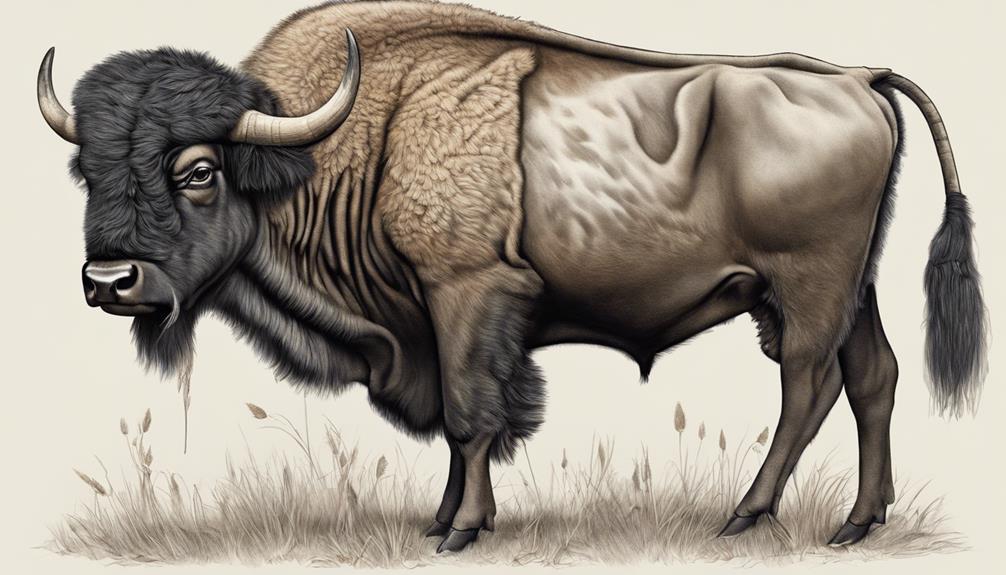
When it comes to animals resembling cows, Bison, Yak, Water Buffalo, Wildebeest, and Muskox are fascinating to discover. Bison, known as the American buffalo, are the largest land mammals in North America, standing over 6 feet tall at the shoulder. Yak, found in the Himalayas, have unique features like shaggy coats and live in social herds. Water Buffalo, the Asian workhorse, are essential for various daily tasks and thrive in wet conditions. Wildebeest, African migrators, partake in annual migrations and benefit predators. Muskox, Arctic survivors with thick coats, show resilience in harsh environments. Each creature presents interesting facts to explore further.
Key Takeaways
- Bison: Resemble cows with a distinctive hump and large size, iconic to North America.
- Yak: Himalayan grazers similar to cows, resilient in high altitudes with shaggy coats.
- Water Buffalo: Asian workhorses akin to cows, domesticated for various tasks, thrive in wet conditions.
- Wildebeest: African migrators resembling cows, known for annual migrations and grazing habits.
- Muskox: Arctic survivors with woolly coats, forming herds for protection in extreme conditions.
Bison: The American Icon
Bison, known as the American buffalo, stand as iconic symbols of the American West. These majestic creatures, the largest land mammals in North America, possess a distinctive hump on their shoulders and massive heads. Weighing up to 2,000 pounds and towering over 6 feet tall at the shoulder, Bison are truly impressive animals that once roamed the plains in enormous herds.
In the 19th century, Bison faced near extinction due to overhunting and habitat loss. However, through conservation efforts, their numbers have slowly recovered. Today, Bison can be found in protected areas and national parks across the United States, where they continue to captivate visitors with their sheer size and beauty.
With their strong resemblance to cattle, Bison play a vital role in maintaining the ecosystem of the American West. Their grazing habits help shape the landscape and promote biodiversity, making them essential components of the region's natural heritage.
Yak: The Himalayan Grazers

Nestled in the towering peaks of the Himalayas, yaks stand as resilient grazers known for their adaptability to high altitudes and harsh mountain environments. These domestic cattle, originating in the Himalayan region, are essential to local communities as sources of milk, meat, fiber, and even transportation.
Yaks boast unique physiological features, such as enlarged lungs and hearts, enabling them to thrive in the challenging mountain terrain. Their shaggy, insulating coats protect them from extreme cold, making them well-suited for the rugged conditions they inhabit. These hoofed animals are highly social, often forming herds that play an important role in the traditional lifestyle of Himalayan regions.
Renowned as beasts of burden, yaks have been integral to the livelihoods of those living in these high-altitude areas for generations. Their resilience and adaptability make them fascinating creatures to study in the context of their Himalayan habitat.
Water Buffalo: The Asian Workhorse

Water buffaloes, widely recognized as the Asian workhorses, play an essential role in various aspects of daily life across Asia. These powerful animals are vital for tasks ranging from plowing fields to transporting goods. Their remarkable strength and ability to thrive in wet conditions make them invaluable partners for farmers and laborers. Water buffaloes have been domesticated for thousands of years, becoming integral to the livelihoods of many communities. Their adaptability to hot and humid climates makes them well-suited for working in challenging environments like paddy fields and swamps. In addition to their labor contributions, water buffaloes provide milk, meat, and hides, serving as versatile assets for those who depend on them.
Interestingly, water buffaloes have also found their way to places like the United States, where they're raised for meat production. In regions like New York, these animals are valued for their meat quality and are raised to meet the demand for buffalo meat in the market.
Wildebeest: The African Migrators
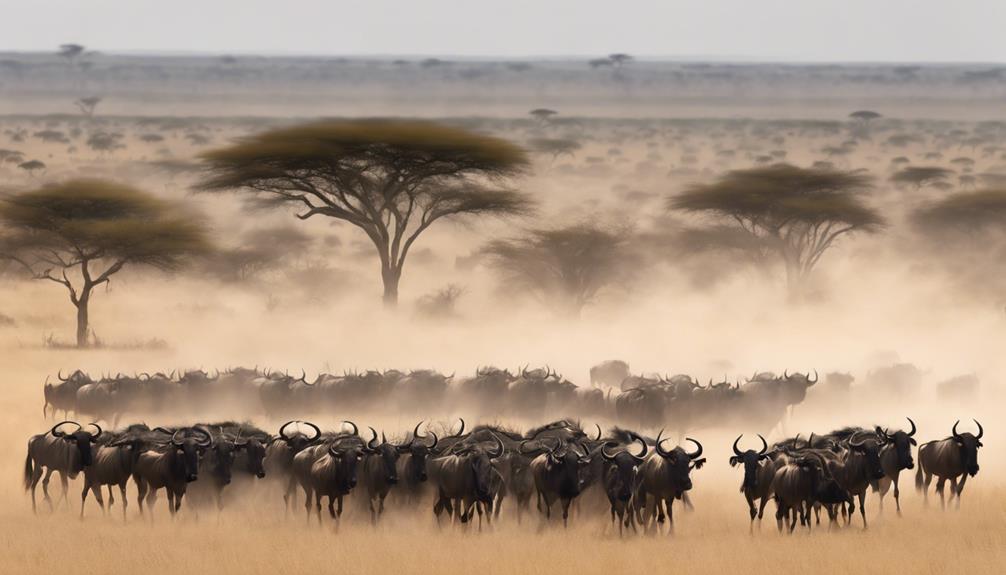
Having explored the significance of water buffaloes in Asian agriculture, the focus now shifts to the remarkable wildebeests of Africa and their iconic migratory patterns. Wildebeests, also known as gnus, are large antelopes found in central Africa. These majestic creatures are known for their annual migration, where millions of wildebeests, both males and females, travel long distances in search of greener pastures. One of the distinguishing features of wildebeests is a white stripe running down their sides, adding to their unique appearance. Standing tall at the shoulders, wildebeests have a large head, beard, and horns, making them easily recognizable in the wild.
Wildebeests play an important role in the ecosystem by grazing on grasslands, which helps shape the landscape and promote the growth of diverse plant species. Their migration also benefits predators like lions, hyenas, and crocodiles, who rely on the abundance of wildebeests for food. Witnessing the incredible sight of wildebeests on the move is a demonstration to the beauty and harmony of nature's cycles.
Muskox: The Arctic Survivors
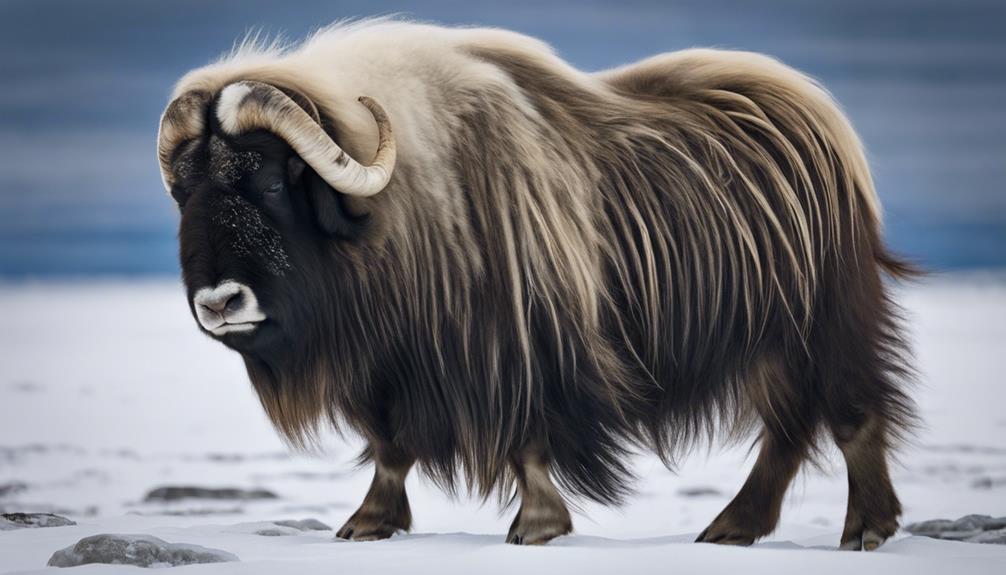
Surviving harsh Arctic climates, Muskoxen are large, shaggy mammals known for their thick coats and distinctive appearance. These resilient creatures, similar to cattle and Bison, have been thriving in the Arctic for thousands of years. Standing around 5 to 6 feet tall at the shoulder, Muskoxen are well-adapted to the frigid tundra environments they call home. Let's take a closer look at some fascinating facts about these Arctic survivors:
| Fact | Description | Importance |
|---|---|---|
| Thick Coats | Muskoxen have thick, woolly coats that provide insulation against the cold. | Essential for survival in freezing Arctic climates. |
| Social Herds | Muskoxen form tight-knit herds to protect each other from predators. | Strength in numbers for defense and social bonds. |
| Conservation Efforts | Muskox populations declined but have rebounded due to conservation initiatives. | Showcases resilience and importance of preservation. |
These remarkable creatures have not only adapted to extreme conditions but also showcase the power of conservation efforts in protecting vulnerable species.
Frequently Asked Questions
What Animals Are Similar to Cows?
Similar to cows, various animals share resemblances in body shape, size, and coloration. From antelopes like eland, bongo, greater kudu, sitatunga, to nyla, these creatures exhibit features that might evoke thoughts of cows.
What Dinosaur Is the Cow Ancestor?
Exploring the enigmatic past, I reveal the Eoceratops as the fascinating predecessor of cows. This plant-eating dinosaur from the late Cretaceous period shares unexpected similarities with our modern bovine companions.
What Is Closely Related to Cows?
Closely related to cows are bison, buffalos, and certain wild bovids in the Bovinae subfamily. These animals share common ancestry and physical features with cows, making them fascinating creatures to explore in the animal kingdom.
What Extinct Animal Was the Ancestor of Cattle?
The ancestor of cattle was the Aurochs, a majestic beast that roamed ancient lands. Extinct since 1627, these creatures were formidable in size and power, shaping the lineage of our domesticated companions.
Conclusion
So, there you have it – five fascinating creatures that resemble cows in various ways.
From the iconic bison to the majestic yak, each animal brings its own unique characteristics to the table.
Whether you're interested in learning about the diverse habitats they call home or the important roles they play in their ecosystems, these animals are definitely worth exploring further.
Keep your eyes peeled for these cow-like creatures in the wild and see if you can spot them for yourself!
Dana is our Lead Content Writer, bringing a wealth of knowledge and expertise to our team. With a background deeply rooted in animal studies and a profound love for all creatures, Dana is dedicated to crafting engaging and informative content that resonates with our audience. With Dana at the helm, you can trust that our content is accurate and engaging, catering to the diverse interests of animal enthusiasts everywhere.
Animals
7 Stunning Gray Birds With Red Chests
Uncover the beauty of 7 stunning gray birds with fiery red chests, each with unique traits that captivate nature enthusiasts worldwide.

Imagine spotting these 7 stunning gray birds with fiery red chests: the African Grey Parrot with its regal beauty, the Red-faced Warbler standing out in high elevation forests, the fearless Western Kingbird, the majestic Pileated Woodpecker with its drumming sounds, the vibrant Red-capped Manakin found in tropical rainforests, the charismatic Red-bellied Woodpecker, and the bonus Scarlet Tanager. Each bird adds a unique touch to nature's palette, showcasing vibrant colors in the wild. Their distinctive features and behaviors make them fascinating to observe.
Key Takeaways
- African Grey Parrot: Striking grey with red tail and subtle red feathers, known for intelligence and mimicry.
- Red-faced Warbler: Slate-gray body with striking red face and throat, thrives in higher elevation forests.
- Western Kingbird: Sleek with concealed red crown patch, aggressive defender, easily recognizable in habitat.
- Pileated Woodpecker: Large woodpecker with red crest, loves dead wood for feeding, majestic drumming sounds.
- Red-capped Manakin: Tropical rainforest bird with bright red crown, famous for courtship dance, vital for seed dispersal.
African Grey Parrot
When I first encountered an African Grey Parrot, its striking grey plumage with subtle hints of red immediately captivated my attention. The regal beauty of these intelligent birds is truly remarkable. The bright red tail adds a pop of color to their appearance, making them stand out among other bird species. Additionally, the subtle red feathers on their heads enhance their unique coloration, giving them a mesmerizing allure.
African Grey Parrots are renowned for their ability to mimic human speech, a trait that has fascinated bird enthusiasts for years. Their striking appearance, coupled with their intelligence, makes them highly sought after as pets. The combination of grey plumage and red accents creates a visually stunning bird that's both beautiful and engaging.
Red-faced Warbler

Easily identified by its striking red face and throat set against a slate-gray body, the Red-faced Warbler is a mesmerizing bird species found in higher elevation forests. These birds thrive in the unique habitats of coniferous and mixed forests, especially during the breeding season. Their presence in such ecosystems greatly contributes to the biodiversity of the region.
Let's take a closer look at some fascinating facts about the Red-faced Warbler in the table below:
| Fact | Description |
|---|---|
| Appearance | Striking red face and throat against a slate-gray body. |
| Habitat | Prefers higher elevation forests, particularly coniferous and mixed forests. |
| Breeding Season | Commonly found in coniferous and mixed forests during this time. |
| Unique Feature | Stands out among other bird species due to its distinctive red face. |
| Ecological Importance | Contributes significantly to the biodiversity of its habitats. |
Red-faced Warblers are not only visually appealing but also play an essential role in maintaining the ecological balance of their habitats.
Western Kingbird
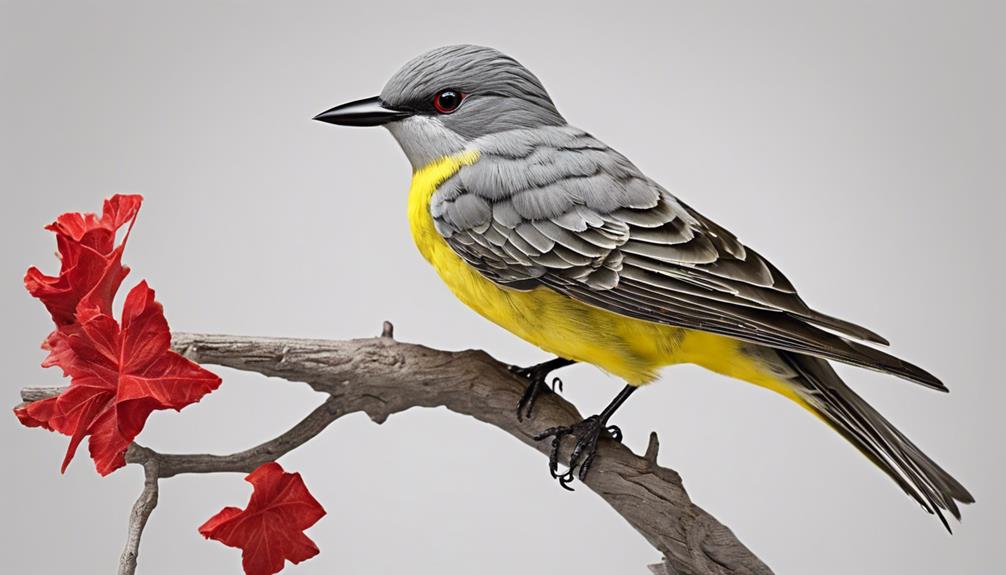
The Western Kingbird, with its sleek appearance and concealed red crown patch, captures attention with its distinctiveness in the avian world. This charismatic species isn't only visually striking but also exhibits fascinating behavior, such as its aggressive territorial defense. When threatened, the Western Kingbird fearlessly chases away larger birds to protect its territory, showcasing its bold and assertive nature. What sets this bird apart is its elegant look, highlighted by the splash of color provided by its unique red crown patch. This distinctive feature adds a touch of vibrancy to its overall appearance, making it easily recognizable in its habitat.
As you observe the Western Kingbird in action, you'll be amazed by its graceful yet feisty demeanor. Its sleek form and eye-catching red crown patch make it a standout presence in the avian world. The Western Kingbird's combination of striking looks and distinctive behavior truly make it a species worth admiring.
Pileated Woodpecker
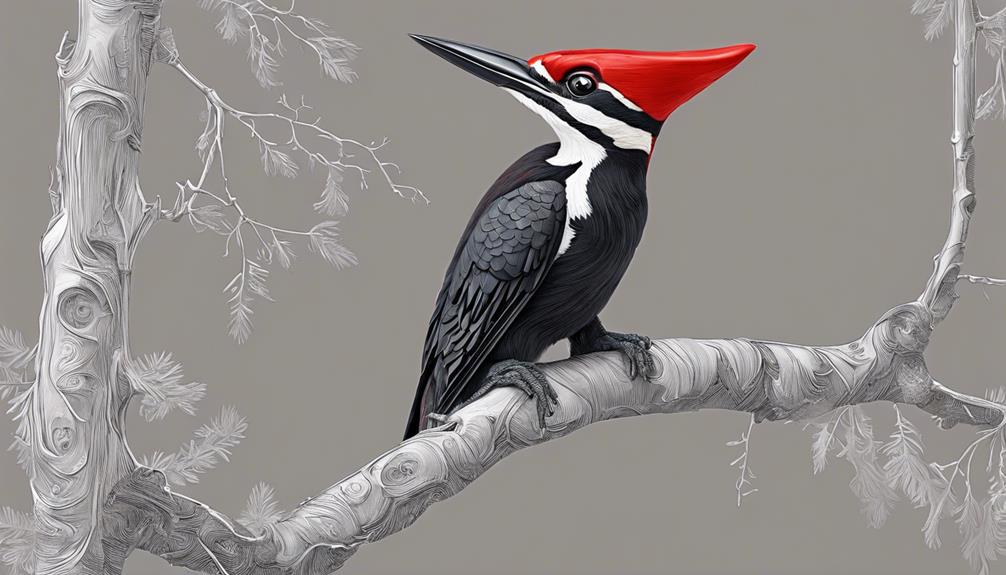
In the domain of charismatic bird species, the Pileated Woodpecker stands out for its remarkable size and striking red crest atop a gray body. As one of the largest woodpeckers in North America, these birds are truly a sight to behold in their habitat.
Their impressive size and distinctive appearance make them a unique addition to the woodland landscape. Pileated Woodpeckers are known for their love of dead wood, where they search for insects to feed on. When foraging, their drumming sounds echo through the forest, a telltale sign of their presence.
The red crest on top of their gray plumage adds a vibrant splash of color to the surroundings, enhancing their overall majestic look. Spotting a Pileated Woodpecker in action is a thrilling experience for any bird enthusiast, offering a glimpse into the fascinating world of these large woodpeckers.
Red-capped Manakin
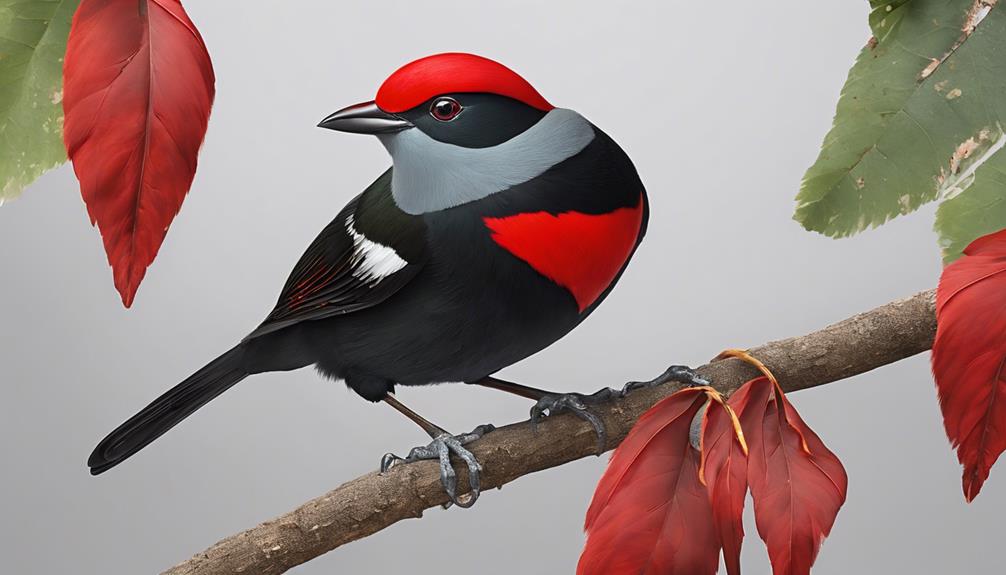
The Red-capped Manakin is a stunning bird found in tropical rainforests, sporting a bright red crown that makes them easily identifiable.
These birds are famous for their unique courtship dance, where the males perform a mesmerizing moonwalk to attract females.
Their vibrant plumage and charismatic behavior set them apart in the avian world, making them a fascinating species to observe in their natural habitat.
Vibrant Red Plumage
Dressed in vibrant red plumage, the Red-capped Manakin captivates with its striking contrast against the dark backdrop of the forest. This bird, with its bright red crown atop a black body, is a sight to behold in lowland tropical forests.
Not only does it add beauty to its forest habitat, but it also plays a vital role in seed dispersal. The Red-capped Manakin's striking red appearance isn't just for show; it serves to allure and mesmerize observers. Its unique courtship behavior sets it apart from other bird species, making it a fascinating subject for study and admiration.
The vibrant red plumage of the Red-capped Manakin truly enhances its charm and charisma in the lush greenery of the forest.
Unique Courtship Dance
Performing their mesmerizing moonwalk courtship dance, male Red-capped Manakins captivate with intricate movements and sounds to attract females for mating. Found in lowland tropical forests, these birds exhibit unique behavior during their mating rituals.
The males, with their bright red crown and black body, showcase their crucial appeal while engaging in this elaborate courtship display. The courtship dance isn't just for show; it plays an essential role in the species' reproduction success.
Tropical Rainforest Habitat
Nestled deep within the lush canopy of Central and South American rainforests, the tropical habitat is essential for the Red-capped Manakin's survival. These vibrant birds, with their bright red crowns and black bodies, rely on the dense vegetation for shelter and food sources.
The unique courtship displays, such as their famous moonwalk dances, not only attract mates but also showcase the health of their habitat. Additionally, Red-capped Manakins aid in seed dispersal, promoting the growth of new plants and maintaining the forest ecosystem's balance.
Without the protection and resources provided by the tropical rainforest, the Red-capped Manakin population would face challenges in finding suitable breeding grounds and sustaining their species over time.
Red-bellied Woodpecker
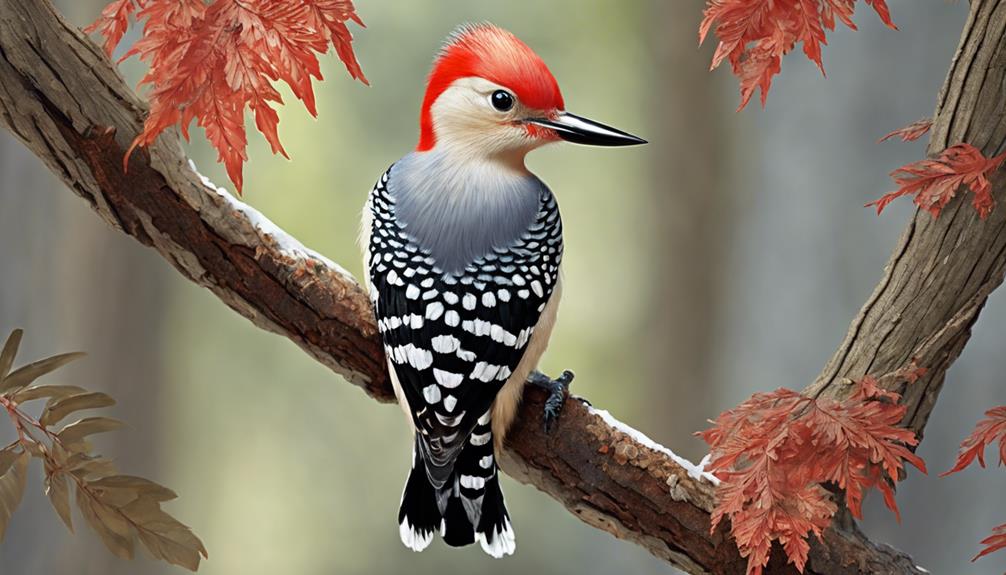
Frequently seen in wooded areas and backyards, the Red-bellied Woodpecker stands out with its vibrant red markings on the head and neck. Despite its name, the red cap on its head is more noticeable than its pale belly. These woodpeckers are expert climbers, using their strong beaks to forage for insects and nuts on tree bark. They're also known to visit backyard feeders, particularly enjoying suet and seeds. Red-bellied Woodpeckers are skilled at excavating cavities in trees for nesting and storing food. Their striking appearance and lively behavior make them a favorite among bird watchers and nature lovers.
Observing a Red-bellied Woodpecker in action is a treat for any bird enthusiast. These agile climbers move effortlessly up and down tree trunks, their vibrant red plumage catching the eye. Their distinct calls can often be heard in the woods, adding to the symphony of sounds in nature. Keep an eye out for these charismatic birds next time you're out exploring the great outdoors!
(Bonus) Scarlet Tanager
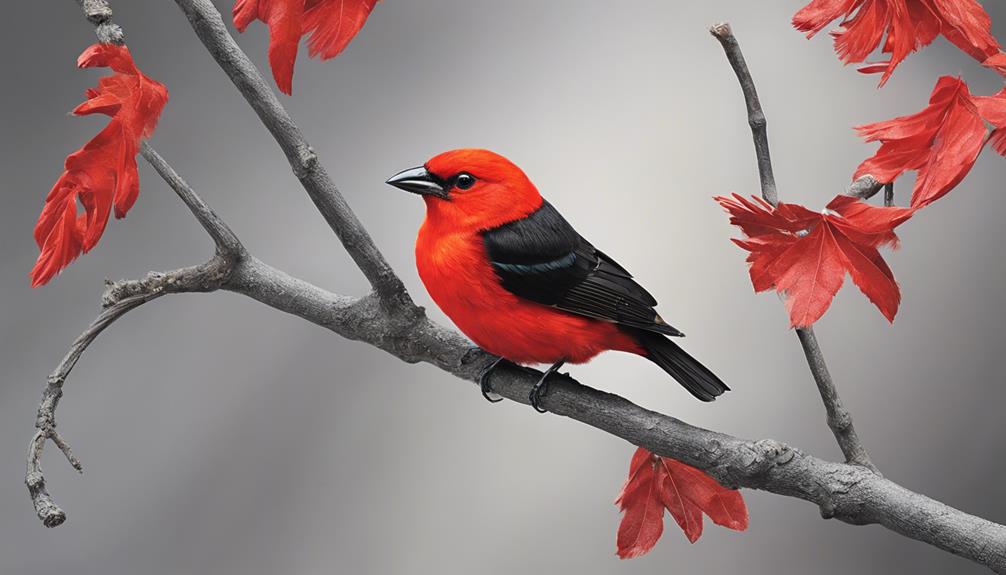
With its deep red plumage and black wings, the Scarlet Tanager is a striking bird found in the eastern US and Canada during the summer. These vibrant birds inhabit forests, woodlands, parks, and even yards, where they play an essential role in controlling insect populations. Male Scarlet Tanagers boast a brilliant red color, while females exhibit a more subtle yellow-green hue, making them a mesmerizing sight for birdwatchers.
During the winter months, Scarlet Tanagers undertake a remarkable journey, migrating to Central and South America in search of warmer climates. Their presence and beautiful songs add color and melody to the surroundings they grace. Observing these birds in their natural habitats can be a delightful experience, showcasing nature's beauty and diversity up close.
Next time you find yourself outdoors in the eastern US or Canada during the summer, keep an eye out for the Scarlet Tanager and admire its stunning deep red plumage contrasting against the backdrop of the forest or woodlands.
Frequently Asked Questions
What Are the GREY Birds With Red Chest?
I'll tell you about gray birds with red chests, like the Scarlet Tanager, Red-breasted Sapsucker, Red-capped Robin, House Finch, and Red-breasted Meadowlark. These birds are stunning and can be found in different regions.
What Bird Has a Reddish Breast?
Curious which bird boasts a reddish breast? The Scarlet Tanager, House Finch, Rose-breasted Grosbeak, Red-breasted Sapsucker, and Scarlet-chested Sunbird all flaunt this vibrant hue on their chests, each adding a touch of natural beauty.
What Bird Looks Like a Sparrow but Has a Red Chest?
Looks like you're interested in birds that resemble sparrows but have red chests. House Finches fit that description perfectly. They're small birds with finch-like bills and vibrant red plumage on their chests.
What Bird Is Black With a Red Chest?
I've found the bird you're seeking – a Scarlet Tanager. This dark beauty flaunts black feathers and a vibrant red chest. In the world of birds, this contrast is simply stunning, making it a sight to behold.
Conclusion
To sum up, these 7 stunning gray birds with red chests are truly a sight to behold in the wild.
From the striking African Grey Parrot to the vibrant Red-capped Manakin, each bird brings a unique beauty to the natural world.
Remember to keep your eyes peeled and binoculars handy next time you're out bird watching, as you never know when you'll spot one of these magnificent creatures fluttering by.
Happy birding!
Dana is our Lead Content Writer, bringing a wealth of knowledge and expertise to our team. With a background deeply rooted in animal studies and a profound love for all creatures, Dana is dedicated to crafting engaging and informative content that resonates with our audience. With Dana at the helm, you can trust that our content is accurate and engaging, catering to the diverse interests of animal enthusiasts everywhere.
-

 Vetted2 months ago
Vetted2 months ago15 Best Cat Foods for Managing Hyperthyroidism – Vet Approved and Feline Friendly
-

 Animal Facts2 months ago
Animal Facts2 months agoSpring Animals: A Guide to Seasonal Wildlife
-

 Vetted2 months ago
Vetted2 months ago15 Best Dog Foods for Kidney Disease – Expert Recommendations for Your Pet's Health
-

 Cats7 months ago
Cats7 months agoTop 5 Cat Breeders in Arkansas: A Guide
-

 Vetted2 months ago
Vetted2 months ago15 Best Fresh Dog Food Delivery Services for Your Pup's Health and Happiness
-

 Rabbits2 months ago
Rabbits2 months agoExploring Rabbit Holes: What Do They Look Like?
-

 Pets2 months ago
Pets2 months agoLatest Pet Statistics in US – Trends & Insights in 2024
-
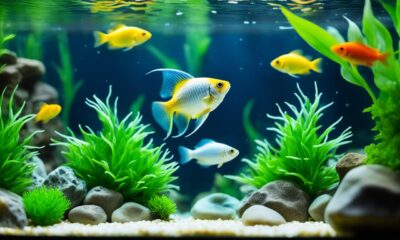
 Fish2 months ago
Fish2 months agoKeeping Your Sucker Fish Thriving at Home





















